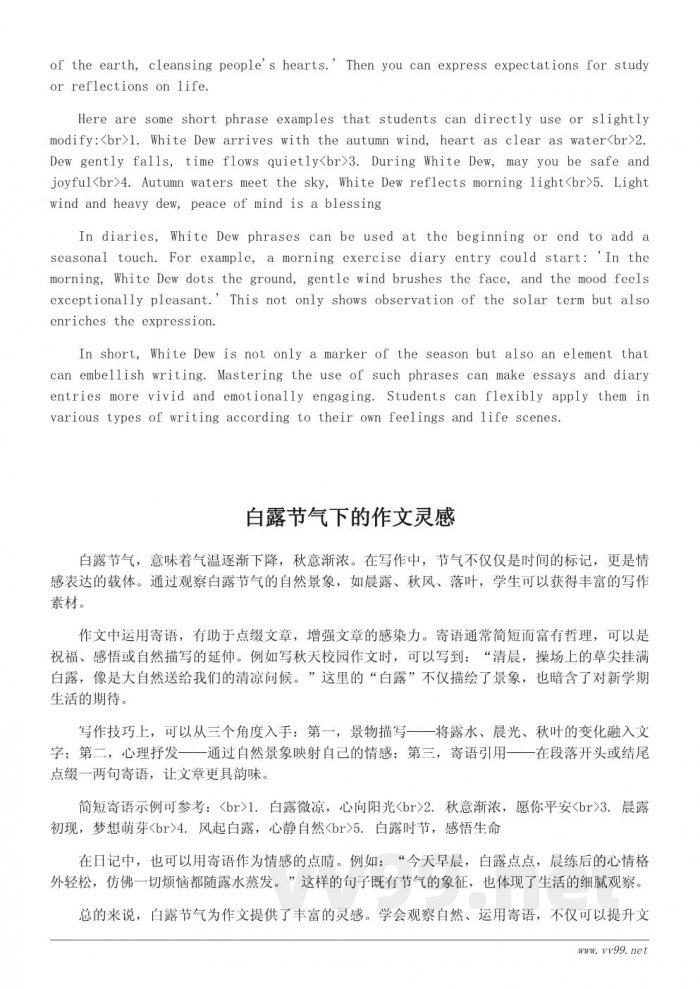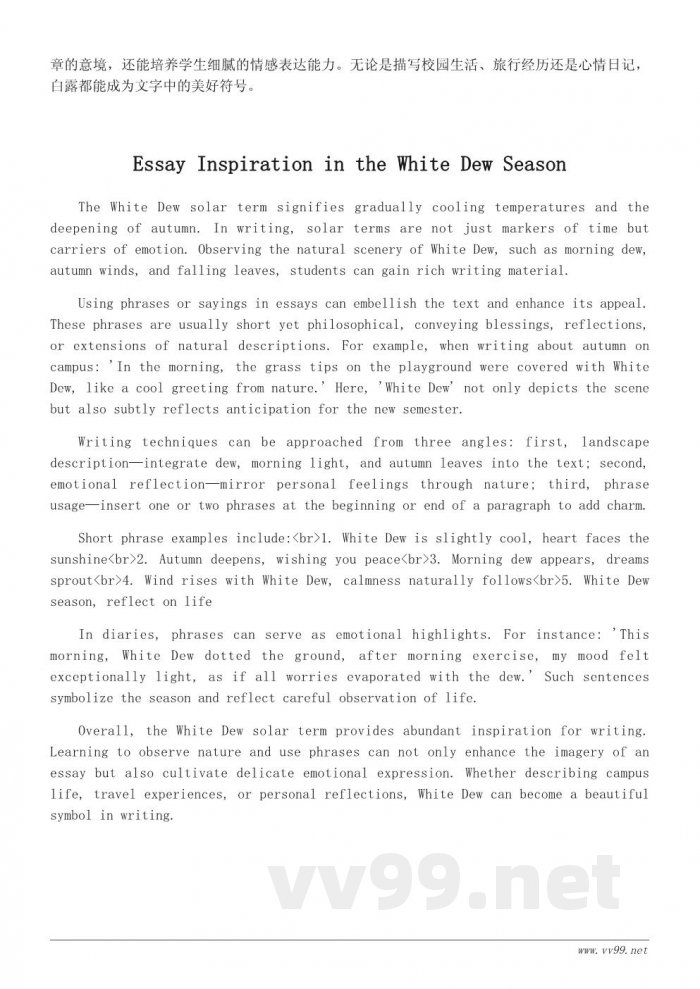白露的清晨与节气韵味
白露,是二十四节气中的第十五个节气,通常在每年的9月7日或8日出现。白露意味着天气逐渐转凉,早晨的草叶上常常挂着晶莹的露珠,如同大自然的温柔问候。古人以白露为标志,感受自然的变化,也寄托了对健康和生活的期盼。
在写作文或日记时,借助白露寄语可以增加文章的诗意和情感。例如,在描述秋天景色时,可以加入“白露秋风清,晨光伴露珠”的句子,让读者感受到节气带来的凉意与宁静。
写作技巧上,可以通过描写景物来引入寄语,如描绘晨雾、露水、秋叶的变化,然后自然过渡到情感或主题。例如,描写校园晨景:“清晨的操场上,白露悄悄落在草尖,像是大地的眼泪,洗涤着人们的心。”接着表达对学习的期许或对生活的感悟。
以下是一些简短寄语示例,学生可以直接引用或稍作修改:
1. 白露秋风至,心境如水清
2. 露珠轻落,岁月静好
3. 白露时节,愿你平安喜乐
4. 秋水共长天一色,白露映晨光
5. 风轻露重,心安即是福
在日记中,也可以用白露寄语开篇或结尾,让文章更有季节感。例如写晨练日记时写道:“清晨,白露点点,微风拂面,心情格外舒畅。”这样不仅体现了对节气的观察,也丰富了文字表达。
总之,白露不仅是季节的标志,更是写作中可以点缀文章的元素。掌握一些寄语的使用方法,能让作文和日记更生动、更有感染力。学生可以根据自己的感受和生活场景,将寄语灵活运用在不同类型的文章中。
The Early Mornings and Charm of White Dew
White Dew is the fifteenth solar term in the traditional Chinese calendar, usually occurring around September 7th or 8th. It signals the gradual cooling of the weather, and in the early mornings, dew often forms on grass leaves, like a gentle greeting from nature. In ancient times, people used White Dew as a marker to observe natural changes and to express hopes for health and a good life.
When writing essays or diary entries, using White Dew phrases can add poetic charm and emotional depth. For example, when describing autumn scenery, you can include sentences like 'White Dew, autumn wind clear, morning light accompanies the dew' to let readers feel the coolness and serenity brought by the season.
In writing techniques, you can introduce such phrases by describing the landscape, such as morning fog, dew, or changing autumn leaves, and then naturally transition to emotions or themes. For instance, depicting a school morning scene: 'On the early morning playground, White Dew quietly falls on the grass tips, like tears of the earth, cleansing people's hearts.' Then you can express expectations for study or reflections on life.
Here are some short phrase examples that students can directly use or slightly modify:
1. White Dew arrives with the autumn wind, heart as clear as water
2. Dew gently falls, time flows quietly
3. During White Dew, may you be safe and joyful
4. Autumn waters meet the sky, White Dew reflects morning light
5. Light wind and heavy dew, peace of mind is a blessing
In diaries, White Dew phrases can be used at the beginning or end to add a seasonal touch. For example, a morning exercise diary entry could start: 'In the morning, White Dew dots the ground, gentle wind brushes the face, and the mood feels exceptionally pleasant.' This not only shows observation of the solar term but also enriches the expression.
In short, White Dew is not only a marker of the season but also an element that can embellish writing. Mastering the use of such phrases can make essays and diary entries more vivid and emotionally engaging. Students can flexibly apply them in various types of writing according to their own feelings and life scenes.
白露节气下的作文灵感
白露节气,意味着气温逐渐下降,秋意渐浓。在写作中,节气不仅仅是时间的标记,更是情感表达的载体。通过观察白露节气的自然景象,如晨露、秋风、落叶,学生可以获得丰富的写作素材。
作文中运用寄语,有助于点缀文章,增强文章的感染力。寄语通常简短而富有哲理,可以是祝福、感悟或自然描写的延伸。例如写秋天校园作文时,可以写到:“清晨,操场上的草尖挂满白露,像是大自然送给我们的清凉问候。”这里的“白露”不仅描绘了景象,也暗含了对新学期生活的期待。
写作技巧上,可以从三个角度入手:第一,景物描写——将露水、晨光、秋叶的变化融入文字;第二,心理抒发——通过自然景象映射自己的情感;第三,寄语引用——在段落开头或结尾点缀一两句寄语,让文章更具韵味。
简短寄语示例可参考:
1. 白露微凉,心向阳光
2. 秋意渐浓,愿你平安
3. 晨露初现,梦想萌芽
4. 风起白露,心静自然
5. 白露时节,感悟生命
在日记中,也可以用寄语作为情感的点睛。例如:“今天早晨,白露点点,晨练后的心情格外轻松,仿佛一切烦恼都随露水蒸发。”这样的句子既有节气的象征,也体现了生活的细腻观察。
总的来说,白露节气为作文提供了丰富的灵感。学会观察自然、运用寄语,不仅可以提升文章的意境,还能培养学生细腻的情感表达能力。无论是描写校园生活、旅行经历还是心情日记,白露都能成为文字中的美好符号。
Essay Inspiration in the White Dew Season
The White Dew solar term signifies gradually cooling temperatures and the deepening of autumn. In writing, solar terms are not just markers of time but carriers of emotion. Observing the natural scenery of White Dew, such as morning dew, autumn winds, and falling leaves, students can gain rich writing material.
Using phrases or sayings in essays can embellish the text and enhance its appeal. These phrases are usually short yet philosophical, conveying blessings, reflections, or extensions of natural descriptions. For example, when writing about autumn on campus: 'In the morning, the grass tips on the playground were covered with White Dew, like a cool greeting from nature.' Here, 'White Dew' not only depicts the scene but also subtly reflects anticipation for the new semester.
Writing techniques can be approached from three angles: first, landscape description—integrate dew, morning light, and autumn leaves into the text; second, emotional reflection—mirror personal feelings through nature; third, phrase usage—insert one or two phrases at the beginning or end of a paragraph to add charm.
Short phrase examples include:
1. White Dew is slightly cool, heart faces the sunshine
2. Autumn deepens, wishing you peace
3. Morning dew appears, dreams sprout
4. Wind rises with White Dew, calmness naturally follows
5. White Dew season, reflect on life
In diaries, phrases can serve as emotional highlights. For instance: 'This morning, White Dew dotted the ground, after morning exercise, my mood felt exceptionally light, as if all worries evaporated with the dew.' Such sentences symbolize the season and reflect careful observation of life.
Overall, the White Dew solar term provides abundant inspiration for writing. Learning to observe nature and use phrases can not only enhance the imagery of an essay but also cultivate delicate emotional expression. Whether describing campus life, travel experiences, or personal reflections, White Dew can become a beautiful symbol in writing.
小提示:上面此文档内容仅展示完整文档里的部分内容, 若需要下载完整文档请 点击免费下载完整文档 。





